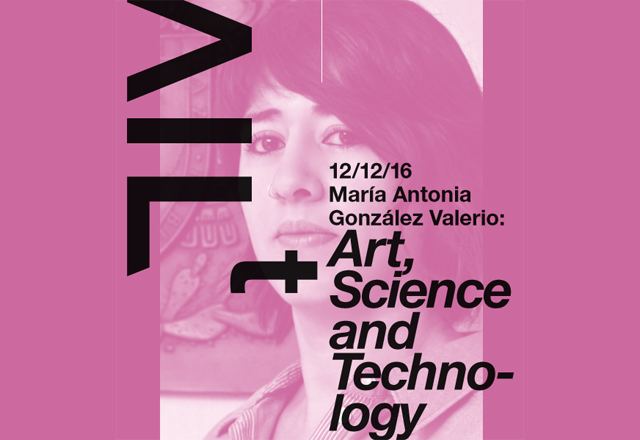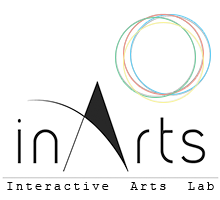AIL-Talk [Vienna, 12/12/16]
07-11-2016 12:27
AIL-Talk, University of Applied Arts Vienna, December 12, 2016 (7 pm)
Art, Science and Technology
Prof. Dr. María Antonia González Valerio (Faculty of Philosophy and Literature, National Autonomous University of Mexico, Mexico City)
How might a theoretical framework from a philosophical perspective be constructed that will allow us to investigate and conceptualize the current state of the interrelationships of art, science and technology? Why would such a framework be significant to assess the range and limits of art and science trends, as well as contribute to developing a project for a philosophy of nature?
To answer these questions, the lecture will outline some of the arguments that constitute the core of a philosophy of nature, from which it is relevant to start and to pose questions as to the biotech arts; what is necessary is a broader horizon that takes into account what ontologies have said about language in the past century as the principal path to pose the question about being.
Programme
Introduction
Univ.-Prof. Dr. Ingeborg Reichle (Department of Media Theory, University of Applied Arts Vienna)
Talk
Art, Science and Technology
Prof. Dr. María Antonia González Valerio (Faculty of Philosophy andLiterature, National Autonomous University of Mexico, Mexico City)
Reception
Biography: María Antonia González Valerio is a philosopher working in the fields of aesthetics and ontology, with a focus on biotechnologies and the arts. Since 2007 she is full professor at the Faculty of Philosophy and Literature, National Autonomous University of México (UNAM). She is the author of three books: Prolegómenos a una filosofía natural. Escritos de ontología estética (Herder, 2015), Un tratado de ficción. Ontología de la mimesis (Herder, 2010) and El arte develado (Herder, 2005). She is co-editor of five books, the most recent: Pròs Bíon: Reflexiones naturales desde el arte, la ciencia y la filosofía (UNAM, 2014). She is the head of the interdisciplinary research group Art+Science based at the UNAM and the coordinator of the arts collective BIOS Ex machinA (workshop for the fabrication of the human and the non-human). In 2012 she curated the bioart
exhibition “Sin origen/Sin semilla (Without origin/Seedless)” at the Museo Universitario de Ciencias y Artes (MUCA) Campus Roma and Museo Universitario Arte Contemporáneo (MUAC).
The AIL-Talk of María Antonia González Valerio is part of the research collaboration “Question about the Limits: Art, Science, and Philosophy” between the Department of Media Theory, University of Applied Arts Vienna, and the Faculty of Philosophy and Literature, National Autonomous University of México, Mexico City. The goal is to
initiate and develop a debate about the relationship of ontology and aesthetics in the age of technoscience from the perspectives of art, the sciences, and philosophy:
During the twentieth century science and technology acquired a dominant role in redefining the concept of life. Technology-driven science and research rendered the basic physical and functional unit of heredity, the gene, accessible to human manipulation, thus turning biology into technology. The genetic code and computer code became interchangeable, opening up new possible constellations for designing the biological sphere. This ground-breaking development went unnoticed in the art world: it was not until the 1990s that artists began to
make increased use advanced technology to explore and create new art forms, such as digital art or hybrid art and even bioart. Science-based art emerged, enhancing progressive encounters with science and technology and shifting the terrain of art towards cutting-edge technologies and the technosciences. With the rise of
bioart, a variety of new materials, such as DNA, bacteria, cells, tissue cultures, and transgenic organisms, entered the art world as a means of artistic expression. Obviously, this also made it necessary for artists to get acquainted with new epistemologies and a new logic of producing reality within the techno-scientific regime. By bringing their artistic endeavour with cutting-edge technology to the public’s attention, science-based art has provoked greater reflection on the limits of manipulating and/or creating life with biotechnology, highlighting the new genome editing technologies like CRISPR and new approaches in the field of synthetic biology, which are cheap and easy to use and are on the point of revolutionizing the question about the ontology of life. Therefore, it is high time to shed some light on the relationship of ontology and aesthetics in the age of technoscience by focusing on the production of art that is related to technoscience; not only because of the technologies it uses — and recently also biotechnologies — but most importantly because from this relationship a model emerges which is fruitful for understanding and interpreting reality. Therefore, the question “What is art?” needs to be posed in the light of an ontology that deals with technoscience and the production of reality within biotechnologies.
Angewandte Innovation Laboratory
Franz-Josefs-Kai 3
1010 Wien
Back


